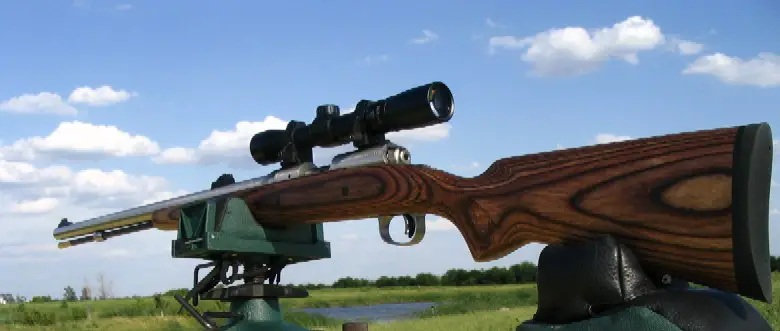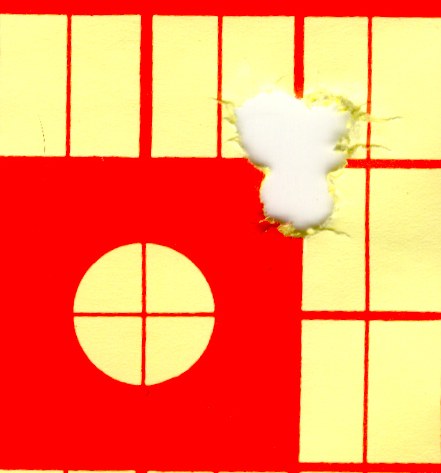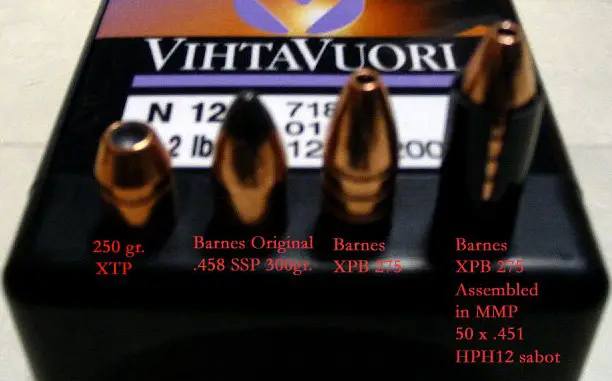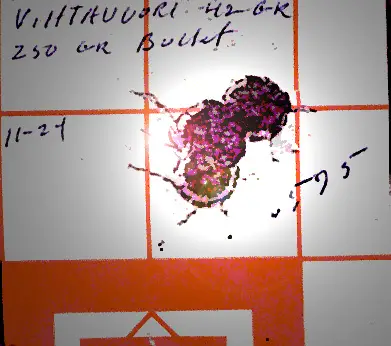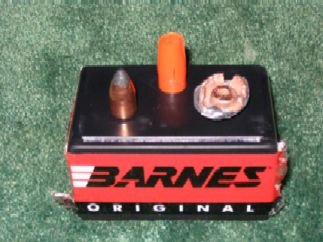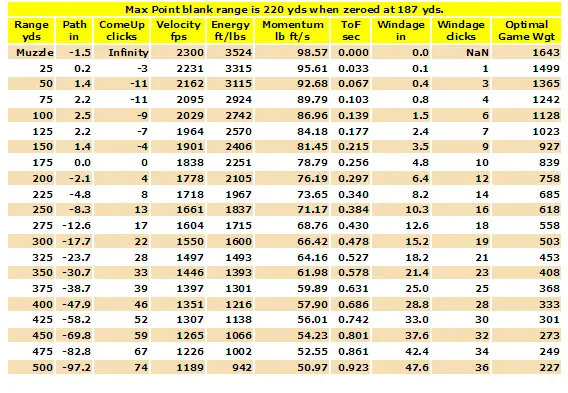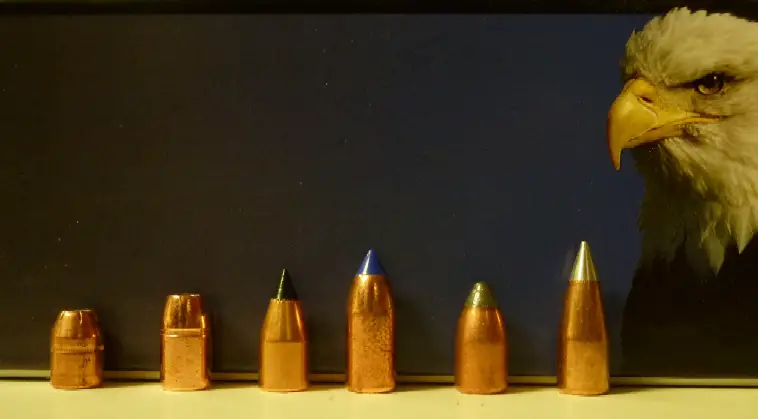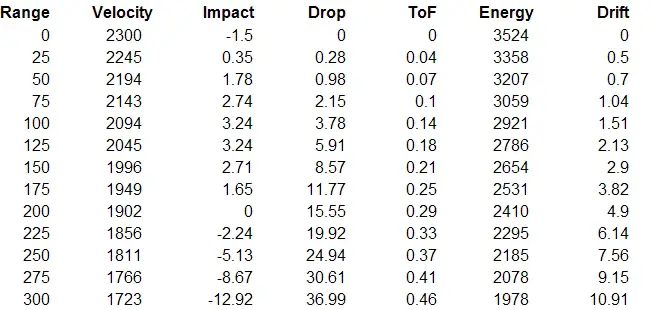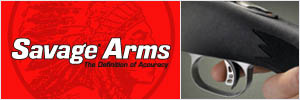


½ MOA and 300 Yard DOA Muzzleloading: Savage 10ML-II
Savage 10ML-II's shoot 1-1/2 in. @ 100 yards out of the box. With a little effort, we can cut those groups in half-- or better, to the limit of our components.
By now, the Savage 10ML series of muzzleloading rifles has achieved ten years of continuous production, making the Savage the longest-running dedicated inline muzzleloader made today. It is also the only inline muzzleloader made today produced by a major bolt-action rifle company. Though Savage Arms was founded in 1894, the rifle upon which the Savage 10ML-II is itself over fifty years old. The first Nicholas Brewer Model 110 rifles appeared in 1958. That was four million rifles ago; the Model 110 being the subject of countless improvements in the last fifty-two years.
If you take a close look at the Savage Model 12 Varmint rifles, it quickly becomes apparent that the 10ML-II is a very similar rifle. It is based on the Savage Model 10 short action, includes the magnum heavy barrel profile, similar recoil lug, pillar bedding, AccuTrigger, and barrel nut. The same barrel and action materials are used, with the same hand straightened, one hundred percent proof tested precision button rifled barrels. The Savage 10ML-II is built to a very high standard of quality and performance, not a cost point, using the same proprietary materials and machining techniques employed on their World Championship F Class rifles at the very same plant. It should come as no surprise that the 10ML-II is capable of unprecedented accuracy considering its heritage. Savage has promised that all 10ML series rifles are capable of 1.5 inch 100 yards accuracy right out of the box. If we do our homework and take care to feed it the right stuff, .5 MOA accuracy and clean 300 yard kills are not at all out of the question, assuming we put in the requisite time and effort. The 10ML-II will essentially shoot to the limit of the components we feed it.
This is actually four shots out of a factory Savage 10ML-II at 100 yards, using the 300 grain Barnes Original .458 Semi-Spitzer Flat Base bullet and the Orange MMP .458 / 50 sabot. It looked so pretty, I decided not to shoot a fifth time on this target.
In the path to getting the most out of Savage 10ML-II's, we should consider what has been established over the last decade. It is not wise to assume that components branded and marketed as "muzzleloading products" apply to the Savage at all. It is not remotely the same rifle as a generic frontstuffer, having a 1:24 rate of twist barrel and has been designed and tested with low-cost, low-residue, non-corrosive, highly consistent propellants in mind. Assuming you have read and have thoroughly absorbed the owner's manual and quick start guides that Savage supplies with every 10ML-II rifle, let's go down the line in our quest for reliability and accuracy.
I. PRIMER
The Savage has always used standard 209 shotshell primers. Special, costly muzzleloading primers are marketed to address the failings of various modern propellants. Avoid them. Right now, the most consistent primers available that I have found are Federal 209A shotshell primers, with CCI 209M primers a close second. The Federal is sturdier; less prone to deformation.
II. SABOT
If there is one secret to accuracy, it is protecting the sabot. It is the sabot that allows the use of more aerodynamic .45 caliber projectiles in a .50 caliber bore, the sabot that quickly obturates and allows for perfect ignition, and it is the sabot that stabilizes the bullet and keeps the bullet concentric to the bore. The sabot also acts as a wiper, maintaining consistent bore conditions shot to shot. No swabbing is suggested or required with the 10ML-II and smokeless between shots, as the propellant residue consisting of light ash is small, and the sabot easily wipes out the majority of it with the very next shot.
We've learned that relatively snug fitting sabots mean tight groups, for a bullet that is eccentric coming out the bore usually isn't accurate. Thinner sabots are stronger as in many gasketing applications, one of the reasons a .429 in. bullet (.44 caliber) in a .50 caliber bore isn't generally accurate. The sabot needs to be the correct length, for petals exceeding the bearing surface on the sides of the bullet can do nothing but interfere with a clean release of the bullet and destroy accuracy. Using the sabot appropriate to the bullet and your individual gun's bore is a critical component of accuracy.
III. BULLETS
Flat-based bullets provide more surface between the bullets themselves and the sabot that wants to shoot itself through the bullet. As a result, flat-based bullets are easier to work with and far less fussy than boat-tail bullets, or any bullets with less than flat bases including those with dished or concave bases. Savage uses a 1:24 rate of twist in their muzzleloading barrels, a bit faster than the industry norm of 1:28. This allows the Savage to stabilize bullets at lower velocities, stabilize heavier bullets, and stabilize pointy, longer, harder to stabilize (but more aerodynamic) bullets than slower twist rates allow. It was selected originally as Savage found that it worked better with more combinations than other twist rates, offering the consumer the most versatile muzzleloading platform.
IV. BULLET-SABOT COMBINATIONS
From the left, the classic Savage test bullet, the 250 grain .452 XTP, the .458 Barnes Original, and the Barnes XPB 275 grain pistol bullet which I used in South Africa. The newer Barnes Spitfire T-EZ 290 grain improves on the 275, offering better aerodynamics and more bearing surface as it lacks cannelures.
There is no such thing as the most accurate bullet or most accurate sabot in the 10ML-II, as they are always used in concert with each other. It is the combination of the bullet, sabot, and your gun's individual bore that makes for consistency. Savage propellant, bullet, and sabot combinations are all optimized for 1:24 Savage barrels. I'll list some of the best and mention why they are especially good.
Hornady .452 250 grain XTP and Hornady 300 grain (non-magnum) XTP with MMP short black sabot.
The 250 grain XTP and short black MMP sabot has long been the standard Savage test loading pushed by 42 grains by weight of Vihtavuori N110 or Hodgdon / IMR SR4759. It yields super velocities (approx. 2300 fps with N110) yet surprisingly mild recoil due to the lighter bullet and decreased powder mass. You can use 36 grains of N110 for a superb low-recoil load as well. It also has the advantage of being the most economical load that can be shot with good accuracy and velocity out of a muzzleloader. It is the place to start, to establish a benchmark for your rifle.
This is a Savage factory 100 yard test target, using a 250 grain Hornady .452 XTP, short black MMP sabot, and 42 grains by weight of Vihtavuori N110. By working up a load for our individual rifle, rather than just three generic shots by Savage, we can often squeeze out even more accuracy.
On game, the Barnes T-EZ 290 Flat Base with the addition of an MMP HPH-12 sabot has no peer. The bear didn't know what hit him. Your rifle may prefer this combination, or it may tell you it likes to be fed Barnes Original Semi-Spitzers that fly slightly flatter. One test is worth a thousand theories.
250 grain .451 Barnes Spitfire T-EZ 250 and Spitfire T-EZ 290 Flat Base with HPH-12 MMP sabots:
Exceedingly consistent by weight with a flat base, these bullets have essentially no velocity limitation on game. The tipped spire point design offers a distinct trajectory advantage over short, stubby bullets. The Barnes bullets are smooth, with no exterior ballistics robbing grooves or cannelures. The #45174 290 grain Barnes Spitfire T-EZ Flat Base has a published BC of .226, a bit on the conservative side (if anything) at 300 yards. Accurate Arms 5744 gives superb ignition with the Barnes T-EZ 290, and at 40-44 grains yields 2000 fps velocity with low recoil and sub-MOA accuracy. For higher velocities, 62-65 grains of Alliant Reloder 7 gets you near the 2300 fps area.
The longest muzzleloading shot I've taken was 287 yards at a pronghorn buck. Others have shown, that under ideal conditions, 300 yard super-clean one shot kills with the Savage 10ML-II are a certainty. That is, of course, if we practice at the ranges we intend to shoot at, thoroughly learn our trajectory, and reduce our range in concert with wind and other ambient conditions.
300 grain Barnes Original .458 diameter Semi-Spitzer Flat Base (#457010) with Orange MMP .458 sabots: These bullets are sold in packages of 50 from Barnes directly or from Barnes dealers. The larger .458 flat base gives an ever greater bearing surface than .451 / 452 projectiles. An ideal long range bullet, its published BC is .291 and is used with the MMP Orange .458 / 50 sabot, the only .458 specific sabot MMP makes.
The .458 300 grain Barnes Orginal Semi-Spitzer Soft-Point Flat Base, the orange MMP .458 / 50 sabot, and a recovered Barnes Original I dug out of hard earth at 150 yards, still retaining 285 grains of weight despite the extremely rough ride. This bullet-sabot combination has blown through clean through 350 pound hogs at ten yards and pronghorn at 287 yards covering both ends of the spectrum superbly. Out of three different Savage 10ML-II's, it has grouped inside 1.5 inches at 250 yards.
Over the last seven years I've been writing about these bullets, it is stunning long range accuracy that has set them apart from the pack fired out of the Savage 10ML-II. 62-65 grains of Reloder 7 or 57-60 grains of Vihtavuori N120 or 67-70 grains of Accurate Arms 2015 net 2300 fps class velocities with this supremely good flying bullet. The parameters of the transonic range as defined by Olin-Winchester begin at 1466 fps, with the most dramatic turbulence often exhibiting itself at roughly 1300 fps and below. This load stays above the destabilizing transonic area to past 325 yards with ease. It still retains 1497 fps and 1493 fpe at 325 yards, corresponding to the Matunas "Optimal Game Weight Formula" value of 453 pounds at that range.
From the left: Hornady 250 grain .452 XTP, Barnes 225 grain .451 "XPB" #45120, Parker 275 grain .450 Ballistic Extreme, Barnes 290 grain T-EZ, Barnes Original #457010 Semi-Spitzer FB .458 300 grain, Parker 300 grain .451 Match Hunter. (Photograph by Randy Wakeman) The latest and best-flying bullet is the Parker Match Hunter 300 grain, which uses the short black MMP sabot. Parker Match Hunter 300 gr. approximate 2300 fps exterior ballistics follow, assuming a 200 yard zero.
V. LOADING PROCEDURES FOR ACCURACY
Accuracy and consistency are synonyms. To that end, we should use all components (primer, sabot, bullet) from the same lot number. Powder charges should be precisely weighed by balance beam or electronic scale.
We should not be able to feel heat coming off the barrel prior to loading, for it is far hotter where we are seating our sabot. As good as modern sabots are, heat will soften and weaken them. A cold barrel can mean hot, tight groups.
Sabots should load firmly, yet smoothly. Canting or cocking a sabot during loading can adversely affect accuracy. The "Spinjag" rotating jag (available from http://spinjag.com) allows steady pressure on the ramrod, rotates with the bullet so the ramrod does not have to, and prevents any scoring or deformation of the bullet during loading.
Naturally, a witness mark on the ramrod is always used and always referred to, which absolutely postively mechanically prevents any bench errors in loading, as in double powder charges. Always have and use a witness mark to confirm that your rifle is loaded correctly and of course remove your ramrod before firing.
The rest is up to us. Starting with proven combinations like the 250 grain Hornady XTP and short MMP sabot with charges listed in your owners manual is a very good confidence-inspiring baseline. From there, it is up to us to discover what works best under our ambient conditions and in our personal rifle. Some have said that rifles are like women, always individuals. Well, maybe. The Savage 10ML-II is a one of a kind muzzleloader, but we necessary must give it some attention if we want it to perform at its best. It is a one-time process, the Savage 10ML-II is a lifetime rifle, and getting the most out of it only adds to the enjoyment of it and what we all seek: quick, clean, one-shot kills with 100 percent game recovery.
© Copyright 2003-2011 by Randy Wakeman. All Rights Reserved.
Please Note: Randy Wakeman, his agents, heirs and assigns, hereby disclaims all possible liability for damages including, actual, incidental and consequential, resulting from usage of the information or advice contained in these articles. Use the data and advice at your own risk, and with extreme caution.



